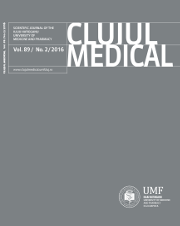Effects of sleeve gastrectomy on insulin resistance
DOI:
https://doi.org/10.15386/cjmed-576Keywords:
morbid obesity, insulin resistance, sleeve gastrectomyAbstract
Background and aim. Obesity is a major risk factor for the onset of insulin resistance (IR), hyperinsulinemia and type 2 diabetes mellitus (T2DM) Evidence data has proven that beyond important weight loss bariatric surgery especially Roux-en-Y gastric bypass (RYGB) and bilio-pancreatic diversion (BPD) leads to significant early reduction of insulinemia and of IR calculated through the homeostatic model assessment (HOMA-IR), independently of fat mass decrease. Sleeve gastrectomy (SG) is now used as a sole weight loss operation with good results. Therefore, the aim of the present study was to investigate the early changes of fasting blood glucose, insulin and HOMA-IR in a group of morbidly obese (MO) patients i.e. at 7, 30 and 90 days after SG.
Methods. The study included 20 MO patients (7 male and 13 female) submitted to SG. Anthropometrical (weight, body mass index –BMI, percent excess BMI loss -%EBMIL) and biochemical (plasma glucose, insulin and calculated HOMA-IR ) evaluation were performed before and at 7, 30 and 90 days after SG. In addition, a second group of 10 normal weight healthy subjects with a BMI ranging form 19 kg/m² to 23.14 kg/m², matched for age and gender was investigated.
Results. Plasma glucose (p=0.018), insulin (p=0.004) and HOMA-IR (p=0.006) values were statistically different between the studied groups. After surgery, at every follow-up point, there were statistically different weight and BMI mean values relative to the operation day (p<0.003). BMI, decreased at 7 days (estimated reduction=2.79; 95% CI:[2.12;3.45]), at 30 days (estimated reduction=5.65; 95% CI:[3.57;7.73]) and at 90 days (estimated reduction=10.88; 95% CI:[7.35;14.41]) respectively after SG. We noted a tendency toward statistical significant change of mean insulin values at 7 days after surgery (corrected p=0.075), no statistical change at 30 days (corrected p=0.327) and a significant change at 90 days (corrected p=0.027) after SG as compared to baseline. There was a significant change in mean values of HOMA-IR at 30 days (corrected p=0.009) and at 90 days (corrected p=0.021) after the operation day.
Conclusions. The present study showed important early changes consisting in reductions of mean values of plasma insulin and HOMA-IR after SG.
Downloads
Published
How to Cite
Issue
Section
License
The authors are required to transfer the copyright of the published paper to the journal. This is done by agreeing to sign the Copyright Assignment Form. Whenever the case, authors are also required to send permissions to reproduce material (such as illustrations) from the copyright holder.

The papers published in the journal are licensed under a Creative Commons Attribution-NonCommercial-NoDerivatives 4.0 International License.

